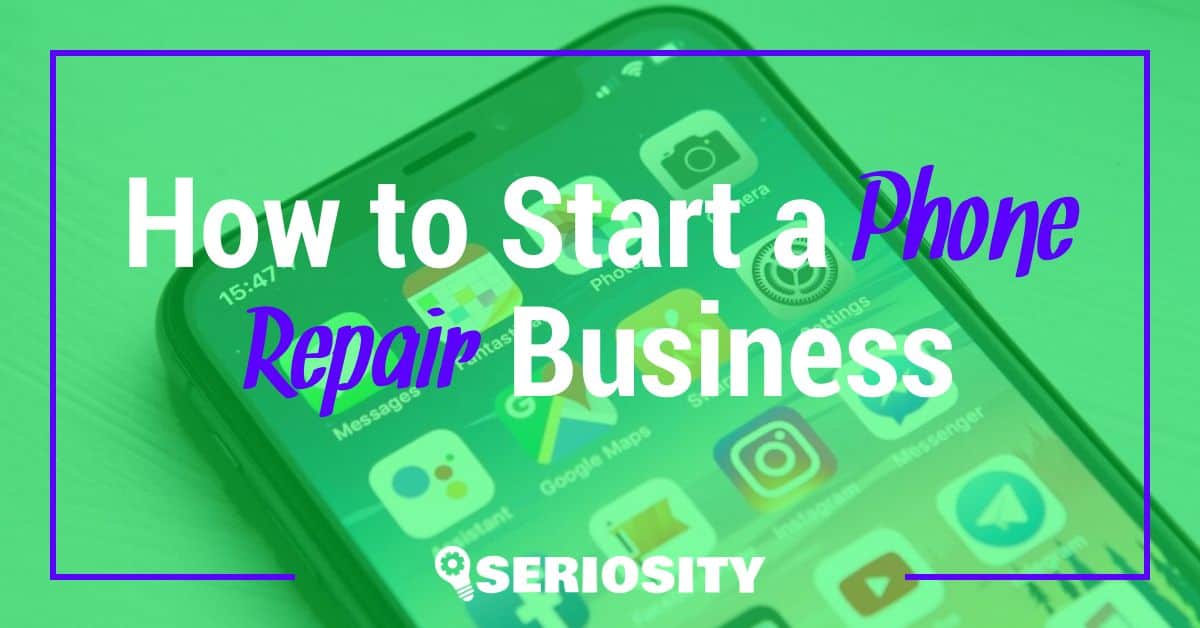In today’s world, cell phones have become an essential part of our lives, making it ever-important for individuals to have access to reliable and cost-effective repair services. With the demand for cell phone repairs on the rise, starting a phone repair business can be a lucrative and fulfilling endeavor. This article will guide you through the process of setting up a successful phone repair business, from the initial planning stages to operational strategies.
Before diving into the details, it’s essential to understand the potential for growth and profitability in the cell phone repair industry. With an increasing number of people relying on their mobile devices for daily tasks, from communication and entertainment to work and finances, a broken phone can bring life to a standstill. As a result, skilled technicians offering affordable and efficient repair services are in high demand. In this industry, keen entrepreneurs will not only find an opportunity for financial success but also the satisfaction of providing a valuable service to their community.
To begin your journey into the cell phone repair business, consideration and planning are vital for success. This includes establishing a solid business plan, honing your technical skills, registering your business, and obtaining necessary licenses and permits. Additionally, adequate funding, creating a professional space for your services, and developing a robust marketing strategy are crucial components in building a thriving cell phone repair business. As we delve deeper into this article, we’ll explore each of these aspects and provide actionable steps to help you achieve success in this industry.
Understanding the Phone Repair Business
Industry Trends
The cell phone repair industry has seen significant growth over the past few years. With the increasing dependency on smartphones and the constant release of new models, consumers often find themselves needing repairs for various reasons, such as cracked screens, battery replacements, and software issues. Some notable market trends include:
- Increasing demand for refurbished phones
- Rising popularity of do-it-yourself (DIY) repair kits
- Growing focus on sustainability and reducing electronic waste
These trends show that there is a rising demand for cell phone repair services, making it a viable business opportunity.
Market Research
Before starting a phone repair business, conducting market research is essential. This involves analyzing your local market, identifying competitors, and understanding consumer needs. You can gather this information by:
- Visiting established phone repair businesses to learn about their services and pricing
- Attending industry-related events, conferences, and seminars
- Connecting with professionals within the industry, such as suppliers and technicians
- Conducting online research to identify market patterns and growth forecasts
Through thorough market research, you gain insight into the demand for repair services, the skills required to cater to various repairs, and strategies for successfully entering the market.
Target Market
Understanding your target market is crucial for setting up a successful phone repair business. Customers for cell phone repair services typically fall into one or more of the following categories:
- Individuals with a broken or malfunctioning phone
- People seeking to save money by choosing repairs over purchasing a new device
- Environmentally conscious consumers looking to reduce electronic waste
Adults aged 18-54 are the most likely to own smartphones, making them a significant portion of your potential customer base. By defining your target market, you can tailor your services, marketing efforts, and pricing strategy to match their needs and preferences.
Developing a Business Plan
A well-structured business plan is essential for starting a successful phone repair business. This plan will serve as a roadmap to guide your decisions and help you secure funding from investors or financial institutions. In this section, we will discuss the key components of a cell phone repair business plan divided into sub-sections.
Executive Summary
The executive summary is an overview of your entire business plan. It should highlight your business’s unique selling points and present a clear vision for the future. Include the following in your executive summary:
- Business name and location
- A brief description of your phone repair services
- Target market and potential customers
- Key objectives and goal
- Financial projections (at a high level)
Market Analysis
A thorough market analysis for your phone repair business enables you to understand the competitive landscape and helps identify gaps in the market. This section should cover:
- Industry Overview: Provide an overview of the cell phone repair industry, including growth trends, market size, and key competitors.
- Target Market: Identify and describe your target customers, including demographic information and their specific needs and preferences.
- Competitive Analysis: Analyze the strengths and weaknesses of your main competitors, and what differentiates you from them. This could include expertise, service times, or pricing.
Financial Projections
The financial projections section of your phone repair business plan should outline your initial investment, projected revenue and expenses, as well as a break-even analysis. This will support your financial planning and demonstrate your ability to manage financial resources.
- Startup Costs: List all the upfront expenses required to start your phone repair business, including equipment, inventory, and permits.
- Revenue Projections: Estimate the annual revenue for your business, considering factors such as the number of potential customers, pricing, and market trends.
- Expenses: Calculate your ongoing operating costs, including rent, utilities, salaries, and marketing expenses.
- Break-Even Analysis: Estimate the point at which your revenue and expenses are equal to determine when your business will become profitable.
In conclusion, your cell phone repair business plan should be concise, comprehensive, and tailored to your unique business goals. By incorporating key components such as an executive summary, market analysis, and financial projections, you’ll be better prepared to launch your new venture and achieve long-term success.
Choosing a Business Entity
When starting a cell phone repair business, selecting the right business entity is crucial in determining the legal organization and ownership of your company. There are four primary business structures to choose from: Sole Proprietorship, Partnership, Limited Liability Company (LLC), and Corporation. In this section, we’ll discuss the features and benefits of each structure to help you make an informed decision.
Sole Proprietorship
A sole proprietorship is the simplest business structure, where you, as the owner, operate the business under your name. This type of business organization has the following characteristics:
- Easy and minimal registration process
- The owner has complete control over the business
- No legal distinction between personal and business assets
- The owner is personally responsible for business debts and obligations
- Income and losses are reported on the owner’s personal income tax return
Partnership
A partnership is formed when two or more individuals come together to establish a business. There are two main types of partnerships: general and limited. In general partnerships, all partners equally share in the management, assets, and liabilities of the business. In a limited partnership, one or more general partners are responsible for managing the business, while limited partners contribute capital and share in the profits, without being actively involved in the management. Characteristics of a partnership include:
- Shared responsibility for management and decision-making
- Partners are personally responsible for the business’s debts and obligations
- Income and losses are divided among the partners and reported on their personal income tax returns
Limited Liability Company (LLC)
An LLC is a popular choice among small business owners, as it combines the limited liability protection of a corporation with the ease and flexibility of a sole proprietorship or partnership. Forming an LLC involves filing articles of organization with the state’s Secretary of State and using an LLC formation service for guidance. Here are the features of an LLC:
- Legal separation between personal and business assets
- Limited liability protection – the owner(s) are not personally responsible for business debts and obligations
- Owners, or members, can decide how the LLC is managed and taxed
- Flexibility in distributing profits among members
Corporation
A corporation is a separate legal entity that is owned by shareholders, created through a more complex registration process. Corporations can be subject to double taxation, where profits are taxed both at the corporate level and when distributed as dividends to shareholders. However, a corporation offers the following benefits:
- Limited liability protection for shareholders – they are not personally responsible for the corporation’s debts and obligations
- Transferable ownership – shares can be bought and sold by shareholders
- Perpetual existence – the corporation continues to exist even if the owner(s) die or sell their shares
In conclusion, choose the appropriate entity for your cell phone repair business based on your desired level of liability protection, simplicity, ownership, and taxation. The choice of business entity can profoundly impact your organization’s operation and future success.
Registering Your Business
Business Name
Before starting your phone repair business, you need to choose a unique and suitable name for your venture. Ensure that you search for the availability of your chosen name and conduct a trademark search to avoid potential legal issues. To register your business name, visit your state’s Secretary of State website and follow the required steps.
Permits and Licenses
To operate your phone repair business legally, you’ll need to acquire necessary permits and licenses:
- Business License: In most states, a business license is required for businesses to operate. Visit your state’s business licensing website to apply.
- Sales Tax Permit: If you plan on selling phone accessories alongside your repair services, you may need a sales tax permit. Visit your state’s department of revenue website for registration.
- EIN (Employer Identification Number): If you plan to hire employees or open a business bank account, you’ll need an EIN, which acts as a business’s social security number. To apply for an EIN, visit the IRS website.
Insurance
Obtaining the right insurance policies can provide protection against potential risks associated with your phone repair business. The following are recommended coverages:
- General Liability Insurance: This coverage helps protect your business from claims arising from third-party bodily injury, property damage, or personal injury.
- Professional Liability Insurance: Also known as errors and omissions insurance, this coverage helps protect your business from claims arising from negligence or failure to deliver professional services.
- Workers’ Compensation Insurance: If you plan to hire employees, workers’ compensation insurance is required in most states. It helps cover medical expenses and lost wages for work-related injuries or illnesses.
Ensure that you research the specific requirements for your state and location, as insurance policies and coverage may vary.
Selecting a Location
When starting a phone repair business, selecting the right location is essential for the success of your venture. This section will cover the importance of conducting market research and setting up an appropriate workstation.
Market Research
Before choosing a location, it’s crucial to conduct market research to understand the local demand for phone repair services. This can help you identify gaps in the market and areas with potential for growth. Consider the following factors during your research:
- Competition: Identify other phone repair businesses in the area, their services, and pricing. Look for areas with moderate competition or unmet demand.
- Target customer profile: Determine the demographics and needs of the potential customer base in the area. This can help you tailor your services and identify suitable locations for your business.
- Accessibility: Choose a location that is convenient and easily reachable for your target customers. This can be near public transportation, shopping centers, or high foot traffic areas.
Workstation
Your workstation is where the actual repair work will take place, so it should be designed for efficiency and productivity. Here are some aspects to consider when setting up a workstation:
- Workspace: Ensure you have ample space for the repair process, storage of equipment and inventory, and to accommodate customers. Consider a location with flexible layout options in case you need to expand in the future.
- Tools and equipment: Invest in high-quality repair tools and equipment, as well as storage solutions to keep your workstation organized.
- Lighting: Proper lighting is vital for accurate repair work, so make sure you have sufficient natural and artificial light sources.
In summary, selecting the right location and setting up an efficient workstation are vital for the success of your phone repair business. Conduct thorough market research to understand the local demand and competition, and design a workspace that fosters productivity and accuracy in the repair process.
Acquiring Essential Tools and Skills
Tools Requirement
Starting a phone repair business requires a collection of essential tools to perform various tasks efficiently. Here is a list of must-have repair tools:
- Nylon Spudger
- Fine Tipped Curved Tweezers
- Screwdriver Kit
- Plastic Triangle Opening Tool
- ProtectionPro Kit
- Precision Knife Set
- Anti-static Brush
- Suction Cup Pliers
- Magnetic Mat
- Magnifying Glass
- Desk Lamp
- Soldering Iron
These tools will help you in tasks such as opening phone cases, handling small components, and soldering. It’s crucial to invest in high-quality tools to ensure durability, precision, and ultimately, excellent repair services for your customers.
Training and Education
To successfully run a phone repair business, you need to acquire phone repair skills, either through self-learning or attending a technical institute. There are many online courses and videos available that can help you learn cell phone repair. Some technical institutes also offer specialized courses that cover all types of phone repairs, from basic hardware to advanced troubleshooting.
Additionally, it’s helpful to obtain certifications from recognized organizations, which adds credibility and trust to your business. Customers will be more inclined to choose your services if they know that you possess the required skills and knowledge.
In conclusion, starting a phone repair business entails acquiring both essential tools and skills. Ensure that you invest in quality tools and receive the necessary training and education to stand out in the competitive phone repair market.
Funding Your Business
Investment
One way to finance a phone repair business is through personal investment. This can involve using your savings or seeking investments from family and friends. The advantage of using personal investment is that it allows you to retain full control of your business, without the pressures of repayments or sharing profits. However, if your personal funds are limited, this method may not provide enough capital for growth.
Bank Loans
Another option for funding a phone repair business is to apply for a bank loan. This may involve submitting a detailed business plan and financial projections to convince the bank that your business will be profitable. Banks typically offer the following types of loans:
- Term loans: a lump sum of money to be repaid over a fixed period with interest.
- Line of credit: a flexible borrowing limit that can be drawn and repaid as needed.
When obtaining a bank loan, it is crucial to have a solid credit history and to prepare for possible collateral requirements.
Alternative Funding Options
For those who cannot rely on personal investment or bank loans, there are alternative funding options available:
- Crowdfunding: Raising funds online through platforms like Kickstarter or Indiegogo, where supporters contribute money in exchange for rewards or equity.
- Peer-to-Peer lending: Platforms like LendingClub or Prosper allow businesses to borrow directly from individuals, typically at lower interest rates than traditional bank loans.
- Government grants and loans: Local and federal government programs may provide funding or low-interest loans to support the growth of small businesses. This may require significant research and application processes, and eligibility may be dependent on factors like location and industry.
Exploring different funding options can help you secure the necessary capital to start and grow your phone repair business. Regardless of the chosen method, it is essential to have a clear plan and budget to ensure your business’s financial success.
Marketing Your Business
Effective marketing is essential for any phone repair business, regardless of its size or annual revenue. Your marketing strategy should aim to promote your brand and establish a solid customer base, contributing to profits in the long run. This section covers key marketing techniques, including your website, business cards, brochures, and targeted advertising.
Website
Establishing a professional website is crucial for your phone repair business plan, as it provides potential customers with essential information about your services. A well-designed website can also help you build a strong online presence and brand identity. Consider incorporating the following elements:
- User-friendly navigation
- Mobile-responsive design
- Content that showcases your expertise in phone repair
- Contact information and an appointment booking system
- Testimonials and reviews from satisfied customers
Business Cards and Brochures
Business cards and brochures are important tools for promoting your phone repair business offline. Provide essential information about your services while maintaining visual appeal:
- Clearly display your logo, contact information, and key services
- Use a professional design that reflects your brand values
- Distribute your business cards and brochures at events or locally to potential customers
Targeted Advertising
Targeted advertising is an important aspect of a successful marketing strategy. By defining the target audience for your phone repair business, you can create more effective advertisements that generate higher returns on investment:
- Consider the age group, income level, and experience with phone repair of your ideal customer
- Utilize retargeting techniques, such as email and text messaging campaigns
- Advertise on platforms where your target audience is active, such as social media channels, search engines, or industry-related websites
Remember to keep your messages clear and concise to convey your brand’s value proposition effectively. By implementing these marketing approaches, your phone repair business is better positioned for success and sustained profitability.
Assessing Financial Potential
Revenue Streams
There are multiple ways to generate revenue in a mobile phone repair business:
- Repair Services: Primary source of income in a phone repair business comes from fixing broken screens, malfunctioning speakers, or malfunctioning charging ports.
- Accessory sales: Selling phone accessories such as cases, screen protectors and chargers can provide an additional income stream.
- Training workshops: Offer training sessions on repair techniques to enthusiasts, generating income from training fees.
- Device resales: Refurbishing and reselling used phones can capitalize on customers looking for a more affordable option.
Expenses
Starting a mobile phone repair business entails various expenses. Some of the primary expenses include:
- Tools and equipment: Screwdrivers, tweezers, soldering tools, microscope and more, depending on the services offered.
- Spare parts: Screens, batteries, buttons, and other components must be kept in stock.
- Rent: If you operate from a retail location, you will need to consider rent and utility costs.
- Marketing: Advertising your business through various channels can have associated costs.
- Licenses and permits: Registering your business and acquiring any necessary permits/licenses contributes to the initial investment.
- Insurance: Liability insurance can offer financial protection in case of accidents or damages during repair.
Profit Margins
Profitability in a mobile phone repair business depends on various factors, such as the volume of repairs, expenses, and pricing strategies. Generally, profit margins for repair services can range anywhere from 30% to 50%. Varying your services can help you achieve more reliable revenue streams and improve your profit margins.
| Service | Estimated Profit Margin |
|---|---|
| Screen Repair | 30% – 50% |
| Battery Replacement | 40% – 60% |
| Accessory Sales | 25% – 50% |
| Device Resales | 20% – 40% |
Evaluating the financial potential of your mobile phone repair business requires understanding the balance between these revenue streams, expenses, and profit margins. By carefully assessing these factors, entrepreneurs can make informed decisions about whether to invest in and pursue a particular market opportunity.
Case Studies and Success Stories
Founder Case Studies
There are several founder case studies to learn from when embarking on starting a phone repair business. Let’s look into a few examples:
- Verizon: A major player in the telecommunications industry, Verizon has taken a significant market share for phone repair services. They capitalized on the demand for professional repair services and expanded their offering to meet the needs of their customers.
- DexKnows: DexKnows, an online directory and local search specialist, ventured into the phone repair business and found success in the industry.
- Rossmann Repair Group: Led by entrepreneur Louis Rossmann, Rossmann Repair Group joined the phone repair business and has quickly become an industry leader. Louis’s successful foray into the industry illustrates the potential for entrepreneurs to find lasting success in the phone repair market.
Software Savings
One aspect of maintaining a successful phone repair business is the proper use of resources. By taking advantage of software savings and deals, you can reduce the overhead costs in your business. Here are some potential areas to focus on for cost savings:
- Point of sale systems: Implementing a cost-effective point of sale system can streamline customer transactions, inventory management, and reporting for your phone repair business.
- Scheduling and appointment software: Many successful phone repair businesses utilize scheduling and appointment software to streamline their operations and keep track of customer appointments efficiently.
- Marketing and promotion software: Utilizing cost-effective marketing and promotional software solutions can help your business expand its reach, attract new customers, and strengthen your online presence.
By employing a smart financial strategy and staying aware of available resources and software savings, entrepreneurs can build a thriving phone repair business.





